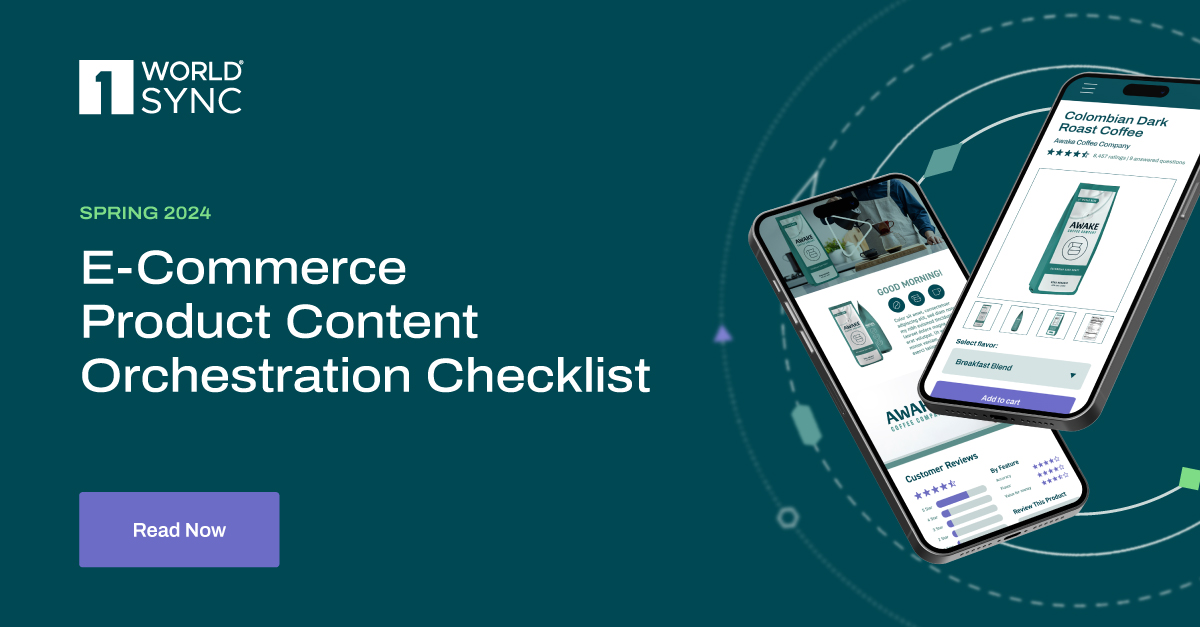Accurate product content is essential to compete in the food service industry. Suppliers and distributors must understand and implement an effective product content strategy to take hold of the market.
In 1WorldSync’s guide to product content strategy in the food service industry, we examine the unique consumer demands of this market and how you can utilize product content to come out on top.
Why Does Product Content Matter in the Food Service Industry?
Suppliers and distributors in the food service industry face a unique challenge regarding retailer expectations and product content. An error in content can stall sales, increase time-to-shelf, and negatively affect trading partner relationships.
Below we highlight a few reasons why (and how) an effective product content strategy is a must for suppliers and distributors in the food service industry.
- Increases customer satisfaction by ensuring the accuracy of product information, such as weights, dimensions, ingredients, and marketing and nutritional information
- Strengthens trust and collaboration between trading partners
- Increases supply chain efficiencies
- Reduces or eliminates delays thanks to fewer measurement errors
- Increases the reliability and efficiency of product transportation and delivery
Creating a Product Content Strategy
You can’t overestimate the importance of quality, accurate, and up-to-date product content. But to reap the benefits of this content, you must implement a product content strategy.
Your product content can and should communicate everything your customers need and want to know about your products.
Below we highlight the essential components of a product content strategy for suppliers and distributors operating in the food service industry.
1. Product Content Transparency and Requirements
Product content transparency is essential, especially within the food service industry. Beyond the standard requirements set by the GDSN, some trading partners require additional attributes or specific requirements for data synchronization.
Your product content strategy must include means by which you fulfill the unique data requirements of your trading partners. By choosing a product information management system built for food service vendors, you can accurately, instantly, and effectively distribute content to your partners, regardless of their data preferences.
2. Data Compliance
Like most suppliers and distributors in food service, you likely work with many retailers, each with varying requirements and regulations. You need a data management system that keeps up with evolving retailer demands –– and keeps your product content compliant.
Your product content strategy must include tools that streamline data edits, updates, and disbursement to various retailers. The right product data automation executes compliance tasks, ensuring you always meet retailer standards.
This helps maintain positive trade partnerships, eliminates manual errors in product data, and strengthens your reputation as a trustworthy brand.
3. Attribute Data Audits
An attribute data audit assesses key product attributes, validating that the attribute information you share with your trading partners matches the product. You can identify discrepancies and validate your attribute data by conducting a physical audit of your product and then comparing it to your existing product content.
Your audits should be conducted against the most recent version of data published in the GDSN for the product being audited.
Data quality is essential for your success within the food service industry. Ensuring accurate, quality attribute data is the first step in providing your partner with the information they need to make a purchase decision.
4. Content Quality and Performance Reporting
In addition to data validation, you want to ensure that the content you provide delivers its intended results. Your product content strategy should include performance reporting with actionable insights that direct the next steps regarding product content.
Real-time performance reporting allows you to monitor content, see your rankings, identify outstanding issues with the product content you share with your trading partners, and take action to remedy those issues.
5. Supply Chain Visibility and Operations
Product content quality impacts the entire supply chain system. Even minor errors in data sharing can cause significant resource loss for your business.
According to a recent GS1 case study, inaccurate transactional data can cost suppliers up to 25 percent more in labor costs. But when suppliers can verify data electronically instead of manually, productivity increases while costs are cut.
In another GS1 data study, researchers found that freight and warehouse management relies heavily on accurate product data. Their findings show that even a 1/4 inch error in case height drastically affected freight and warehouse management. A quarter-inch discrepancy resulted in 1,000 fewer cases per truckload, 20 fewer cases per pallet, and six more trucks than necessary.
Having and presenting accurate product data ensures you’re streamlining supply chain operations and making the most of your time and resources.
Product content strategy is integral to your supply chain operations. And when executed correctly, it delivers consistent, replicable results.
6. Product Information Management
It’s impossible for your team to manage and maintain your product content manually. You need management capabilities that enable global product information sharing while verifying product identity.
Product information management allows you to deliver content to your trading partners, streamlining your content disbursement while preserving your resources. PIM addresses the essential components of a product content strategy we explored above. As the name suggests, it allows you to manage your product content in a simple, efficient, and accurate way.
Below we explore how PIM solutions can transform how you think about and manage your product content.
Streamlined Data Entry
PIM systems allow for a streamlined method of data entry. Your team cannot –– and should not –– manually manage every individual SKU. PIM solutions allow you to update a single entity or your entire partner list instantly while meeting their guidelines and requirements.
Real-Time Data Tracking
Instant data tracking allows you to identify discrepancies in your product content and address those issues as soon as they arise.
Managing Data via a Single Source of Truth
Hosting product data in a central location ensures that all channels present the same information to trading partners.
Scalability
As your business grows, so will your product content needs. PIM solutions allow for scalability, preventing lost time or traction you’ve gained with your partners.
Standardization and Data Compliance
Your product content must align with industry and retailer requirements. Your PIM can automate this process, supporting regional and regulatory standards across the board.
Product Content Strategy: Turning Challenges into Opportunities
Product content is crucial for every distributor within the food service industry. Managing your immense inventory of product content can be challenging, but it doesn’t have to be.
1WorldSync provides the tools and solutions you’re looking for to create a product content strategy that delivers results. Reach out today to learn how our team can help you win your market with data-driven tools and product content management systems built for the food service industry.





